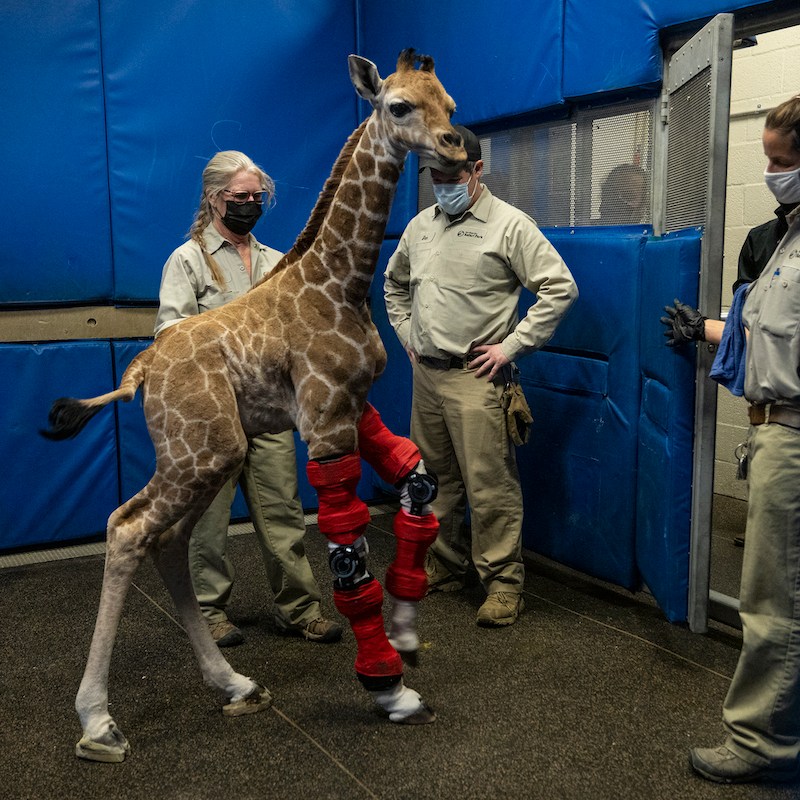
You wouldn’t know it when you see her with the herd, but a giraffe calf at the San Diego Zoo Safari Park has overcome some potentially life-threatening abnormalities.
Videos by TravelAwaits
Msituni, which means “in the forest” in Swahili and is pronounced see-tune-nee, was born February 1. Unfortunately, she was born with a hyperextension of the carpi, bones that are the giraffe equivalent of the human wrist. As a result, her front legs bent the wrong way, which made it difficult for her to stand and walk.
The good news is that thanks to care provided by the San Diego Zoo Wildlife Alliance, a nonprofit international conservation organization, and Hanger Clinic, which operates 875 clinics that deliver orthotic and prosthetic care, Msituni’s legs now work properly.
“We are so glad to have the resources and expertise to step in and provide this young calf the opportunity for a full life,” Dr. Matt Kinney, senior veterinarian at the San Diego Zoo Safari Park, said in a statement. “Without these lifesaving braces to provide support, the position of her legs would have become increasingly more painful and progressed to a point she would not have been able to overcome.”
Ara Mirzaian, certified orthotist at Hanger Clinic, added, “I feel a tremendous sense of accomplishment.”
“I’ve never worked with wildlife before — it’s one of those things that is a once-in-a-lifetime opportunity,” Mirzaian said. “You just have to savor the moment.”

A Life-Threatening Condition
Msituni was born at the San Diego Zoo Safari Park in Escondido, north of San Diego, with hyperextension of the carpi that made it difficult for her to stand and walk, according to the San Diego Zoo Wildlife Alliance.
Her back leg joints were also weak, and, making matters more complicated, Msituni was 5 feet 10 inches tall and weighed more than 100 pounds at birth, according to the Associated Press. Consequently, the combination of ailments took a toll on her health, and safari park staff were concerned Msituni wouldn’t be able to nurse properly or walk around the habitat.

A Unique Approach
Zoos increasingly partner with medical professionals who treat humans with prosthetics and orthotics — and that’s just what happened for Msituni’s treatment.
Msituni’s custom orthotic braces were crafted by Hanger Clinic. While the company typically provides care for humans, members of the team consulted with wildlife care staff to develop a customized plan for Msituni, the San Diego Zoo Wildlife Alliance explains.
The team used moldings of her legs to create custom-molded carbon graphite orthotic braces — complete with a giraffe pattern to look natural.
“We put on the giraffe pattern just to make it fun,” Mirzaian said, the Associated Press reports. “We do this with kids all the time. They get to pick superheroes, or their favorite team, and we imprint it on their bracing. So why not do it with a giraffe?”
Msituni’s other leg self-corrected using a medical-grade brace, so she only needed one customized brace. And after 10 days in that brace, her problem was corrected.

Running With The Herd
All together, Msituni was in braces in the animal hospital for 39 days.
After that, she was slowly reintroduced to her mom and other giraffes, but her mom wouldn’t take her back, according to the Associated Press. The good news, however, is that Msituni was accepted by another adult female, named Yamikani (pronounced ya-me-caanee), and her female calf, Nuru (pronounced nu-roo), who was born four days after Msituni.
“This was an important step in Msituni’s natural development,” said Kristi Burtis, director of wildlife care at the San Diego Zoo Safari Park. “As her bond grows with the herd, she will be able to learn behaviors and skills important to the development of a young giraffe.”
Intrigued and inspired? Be sure to visit all of our wildlife content, including:
